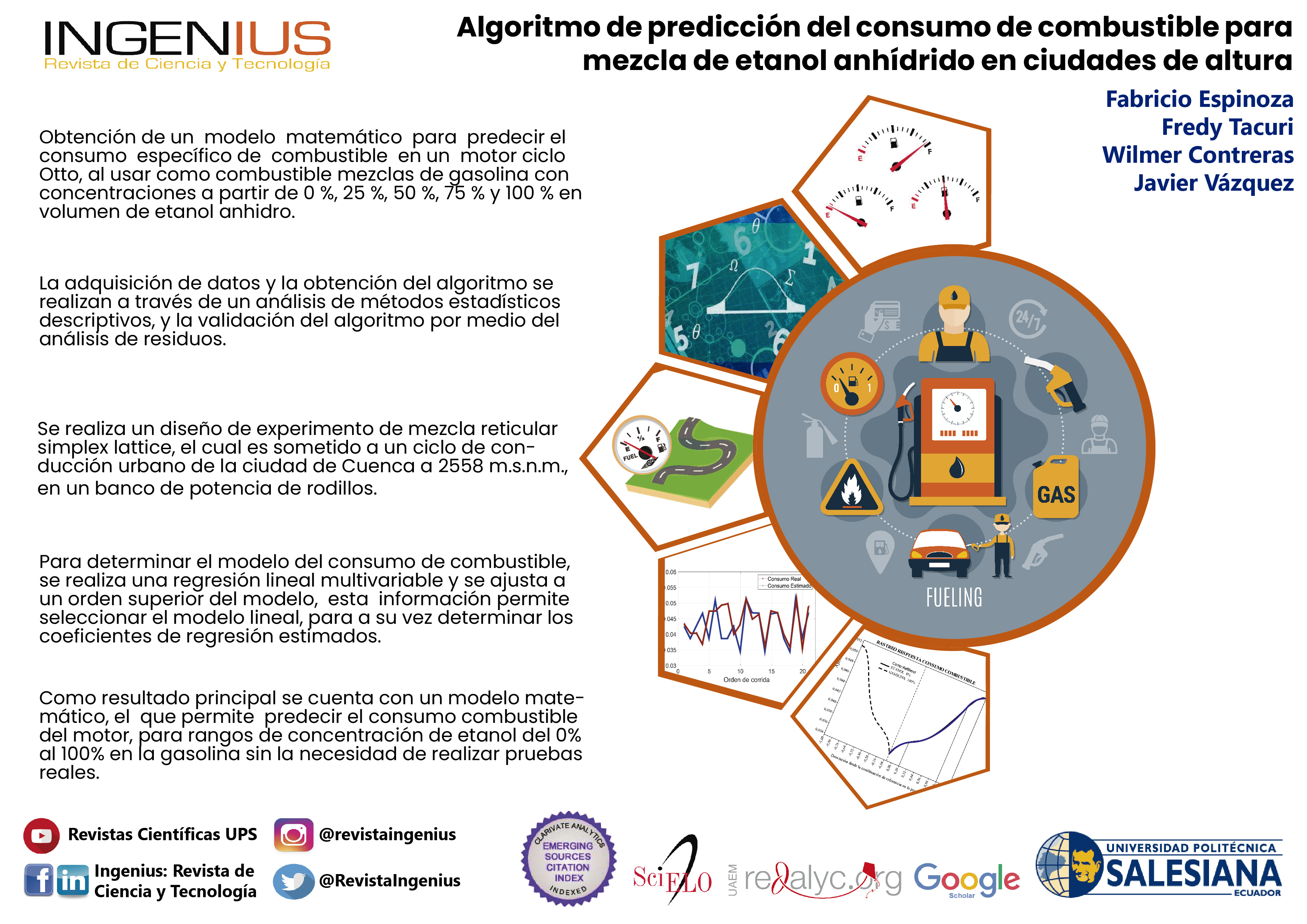Algorithm for predicting fuel consumption for anhydrous ethanol mixtures in high-altitude cities
Main Article Content
Abstract
Article Details
The Universidad Politécnica Salesiana of Ecuador preserves the copyrights of the published works and will favor the reuse of the works. The works are published in the electronic edition of the journal under a Creative Commons Attribution/Noncommercial-No Derivative Works 4.0 Ecuador license: they can be copied, used, disseminated, transmitted and publicly displayed.
The undersigned author partially transfers the copyrights of this work to the Universidad Politécnica Salesiana of Ecuador for printed editions.
It is also stated that they have respected the ethical principles of research and are free from any conflict of interest. The author(s) certify that this work has not been published, nor is it under consideration for publication in any other journal or editorial work.
The author (s) are responsible for their content and have contributed to the conception, design and completion of the work, analysis and interpretation of data, and to have participated in the writing of the text and its revisions, as well as in the approval of the version which is finally referred to as an attachment.
References
[2] H. L. MacLean and L. B. Lave, “Evaluating automobile fuel/propulsion system technologies,” Progress in Energy and Combustion Science, vol. 29, no. 1, pp. 1–69, 2003. [Online]. Available: https://doi.org/10.1016/S0360-1285(02)00032-1
[3] CEPAL, “Consideraciones ambientales en torno a los biocombustibles líquidos,” in División de Desarrollo Sostenible y Asentamientos Humanos, 2008.
[4] S. Fernández Henao, J. Mosquera A., and J. Mosquera M., “Análisis de emisiones de CO2 para diferentes combustibles en la población de taxis en Pereira y Dosquebradas,” Scientia et Technica, vol. 2, no. 45, ago. 2010. [Online]. Available: https://doi.org/10.22517/23447214.385
[5] E. A. Melo Espinosa, Y. Sánchez Borroto, N. Ferrer Frontela, and N. Ferrer Frontela, “Evaluación de un motor de encendido por chispa trabajando con mezclas etanol-gasolina,” Ingeniería Energética, vol. 33, pp. 94–102, 08 2012. [Online]. Available: https://bit.ly/38kOxFW
[6] J. Goñi Delión and M. Rojas-Delgado, “Combustibles alternativos en motores de combustión interna,” Ingeniería Industrial, 02 2014. Online]. Available: https://doi.org/10.26439/ing.ind2014.n032.122
[7] J. Gibbons, Interagency Assessment of Oxygenated Fuels. National Science and Technology Council, 1997. [Online]. Available: https://bit.ly/355W21N
[8] Apace Research Ltd, “Intensive field trial of ethanol/petrol blend in vehicles,” ERDC Project No. 2511, Tech. Rep., 1998. [Online]. Available: https://bit.ly/32iZaFK
[9] R. Ragazzi and K. Nelson, “The impacts of a 10 % ethanol blended fuel on the exhaust emissions of tier 0 andtier 1 light duty gasoline vehicles al 35 f,” Colorado Department of Public Health and Environment, 1999.
[10] B.-Q. He, Jian-Xin Wang, J.-M. Hao, X.-G. Yan, and J.-H. Xiao, “A study on emission characteristics of an efi engine with ethanol blended gasoline fuels,” Atmospheric Environment, vol. 37, no. 7, pp. 949–957, 2003. [Online]. Available: https://doi.org/10.1016/S1352-2310(02)00973-1
[11] T. W. Patzek, S.-M. Anti, R. Campos, K. W. ha, J. Lee, B. Li, J. Padnick, and S.-A. Yee, “Ethanol from corn: Clean renewable fuel for the future, or drain on our resources and pockets?” Environment, Development and Sustainability, vol. 7, no. 3, pp. 319–336, Sep. 2005. [Online]. Available: https://doi.org/10.1007/s10668-004-7317-4
[12] C.-W. Wu, R.-H. Chen, J.-Y. Pu, and T.-H. Lin, “The influence of air-fuel ratio on engine performance and pollutant emission of an si engine using ethanol-gasoline-blended fuels,” Atmospheric Environment, vol. 38, no. 40, pp. 7093–7100, 2004, 8th International Conference on Atmospheric Sciences and Applicat ions to Air Quality (ASAAQ). [Online]. Available: https://doi.org/10.1016/j.atmosenv.2004.01.058
[13] S. T. Coelho, J. Goldemberg, O. Lucon, and P. Guardabassi, “Brazilian sugarcane ethanol: lessons learned,” Energy for Sustainable Development, vol. 10, no. 2, pp. 26–39, 2006. [Online]. Available: https://bit.ly/2JJIeBM
[14] R. K. Niven, “Ethanol in gasoline: environmental impacts and sustainability review article,” Renewable and Sustainable Energy Reviews, vol. 9, no. 6, pp. 535–555, 2005. [Online]. Available: https://doi.org/10.1016/j.rser.2004.06.003
[15] American Coalition For Ethanol. (2005) Fuel economy study: comparing performance and costs of va-rious ethanol blends and standard unleaded gasoline. [Online]. Available: https://bit.ly/32mEmwP
[16] E. Behrentz, Beneficios ambientales asociados con el uso de combustibles alternativos. Centro de Investigaciones en Ingeniería Ambiental (CIIA) Universidad de los Andes, 2008. [Online]. Available: https://bit.ly/38k6cOj
[17] T. Durbin, J. W. Miller, T. Huai, D. R. Cocker III, and Y. Younglove, “Effects of ethanol and volatility parameters on exhaust emissions of light-duty vehicles.” in UC Riverside: Center for Environmental Research and Technology. [Online]. Available: https://bit.ly/3oZFmkp
[18] E. Shapiro. (2006) Roundtable on ethanol fuel: automaker view.
[19] H. S. Yücesu, T. Topgül, C. Çinar, and M. Okur, “Effect of ethanol-gasoline blends on engine performance and exhaust emissions in different compression ratios,” Applied Thermal Engineering, vol. 26, no. 17, 2006. [Online]. Available: https://doi.org/10.1016/j.applthermaleng.2006.03.006
[20] H. R. Acevedo G. and J. M. Mantilla G., “Viabilidad ambiental del uso de biocombustibles para motores a gasolina y diésel en colombia,” Boletin del Observatorio Colombiano de Energía, Bogota. D. C., pp. 3–14, 2008. [Online]. Available: https://bit.ly/38kSXg0
[21] U.S. Department of Energy, “Handbook for handling, storing, and dispensing e85 and other ethanol-gasoline blends,” U.S. Department of Energy, Tech. Rep., 2013. [Online]. Available: https://bit.ly/2U1zVmF
[22] H. Gutiérrez Pulido and R. de la Vara Salazar, Análisis y diseño de experimentos. McGraw-Hill, 2003. [Online]. Available: ttps://bit.ly/36gB7rU
[23] E. A. García, “Modelización termodinámica de un motor turboalimentado y propulsado por bioetano,” 2009. [Online]. Available: https://bit.ly/3k85tBO
[24] INEN, “NTE INEN 2478: Etanol anhidro. requisitos,” Instituto Ecuatoriano de Normalización, Tech. Rep., 2009. [Online]. Available: https://bit.ly/354abwc
[25] ——, “NTE INEN, Gasolina. Requisitos,” Instituto Ecuatoriano de Normalización, Tech. Rep., 2012. [Online]. Available: https://bit.ly/2JLGsQD
[26] Hyundai. (2011) Manual del taller. [Online]. Available: https://bit.ly/356tPIc
[27] S. P. Verma and A. Quiroz-Ruiz, “Critical values for six Dixon tests for outliers in normal samples up to sizes 100, and applications in science and engineering,” Revista Mexicana de Ciencias Geológicas, vol. 23, pp. 133–161, 01 2006. [Online]. Available: https://bit.ly/3eBoOKG
[28] W. Contreras, J. Ortega, and R. Japa, “Aplicación de una red neuronal feed-forward backpropagation para el diagnóstico de fallas mecánicas en motores de encendido provocado,” INGENIUS, pp. 32–40, 2019. [Online]. Available: https://doi.org/10.17163/ings.n21.2019.03

